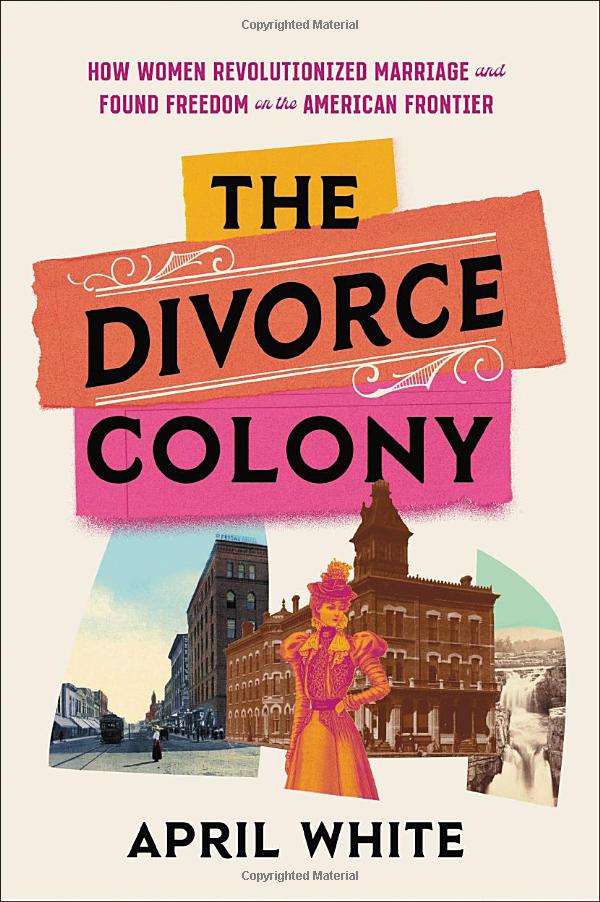
Review by Cassandra Crisman, Washington State University
Publisher: Hachette Books, 2022
Length: 272 pages
Our culture’s fascination with scandal and sensationalism did not begin with the Kennedys or Kardashians, but instead, has roots in the end of the nineteenth-century, when the U.S. press became fascinated with the growing number of women seeking divorce. April White’s The Divorce Colony: How Women Revolutionized Marriage and Found Freedom on the American Frontier tells the stories of four elite women who, when they moved to North Dakota in order to obtain divorces, found themselves at the center of controversy and gossip. White argues that, although they became infamous, they did not seek this attention. Instead, they were “thrust center stage by the men who opposed them and the religious, political, legal, and social impediments they faced,” (xv). Their stories demonstrate how the media used women’s personal lives in order to construct narratives that heightened anxieties about changing cultural norms.
White points out that, while the topic of marriage has been studied by historians, little attention has been paid to divorce. Yet, the late nineteenth-century was a key moment for divorce laws in the United States. At this time, marriage regulation became a matter of the courts, rather than state legislature. Newer states and territories in the west with more relaxed divorce laws and progressive judges became a safe haven for those seeking divorce. In particular, the state of South Dakota only required a 90-day residency before one could file for divorce. This allowed for the growing city of Sioux Falls to become a common destination for people seeking divorce. The Cataract House Hotel, which had the nicest amenities in town but still only a fraction of a room in New York, became the epicenter of those seeking the service, and earned its infamous nickname: the Divorce Colony. Four members of the colony that reached national notoriety are the focus of the work.
White’s book is divided by case studies: Maggie de Stuers, a member of the Astor family whose divorce and fight for parental custody became a daily topic in the press; Mary Nevins Blaine, whose divorce ruined her father-in-law’s political career but enabled her to launch her own acting career; Blanche Molineux, who moved to secure freedom from her husband whom she suspected was a murderer; and Flora Bigelow Dodge, a writer who found happiness in Sioux Falls when she remarried the son of an English lord. She addresses the case studies in chronological order, showcasing the progression of marriage laws in South Dakota as Sioux Falls became a more popular destination for divorce.
White notes how, as the number of people began to pilgrimage to South Dakota seeking divorce, permanent residents worried about their state’s reputation. While most believed divorce was moral in cases of abuse or infidelity, there was a growing concern that people would leave the state as soon as their divorce was final. The people of South Dakota did not want to be the divorce capital of the nation. This led to stricter laws regarding temporary residency, as the state changed residency requirements for those wishing to divorce from a 90-day stay, to one year. Women who filed for divorce were questioned about the validity of their residency, and whether they planned to stay in the state after their divorces were final.
White admits that the women on whom she focuses do not holistically represent the experiences of all turn-of-the-century women who sought to end their marriages.She emphasizes that the women of the case studies were able to make the move to South Dakota because they had access and privilege, coming from white, upper class backgrounds. In order to move across the country and establish temporary residency in a new state, one must have the ability to support oneself, which most women did not have. The women of White’s focus had social and political connections, making their divorces the topic of public speculation. White argues that this allows us to examine public responses to their actions, as well as public attitudes regarding marriage and divorce.
Members of the press followed the divorces as they progressed, gathering in the lobby of the Cataract House in hopes of getting an interview from one of the women. The women’s personal and intimate struggles in life became the topic of public discourse, as the public debated the morality of divorce. In the end, the four women were able to win their cases in court, but the court of public opinion varied. Their stories set a precedent for divorced women in the United States by normalizing divorce in American culture. This is best demonstrated in White’s epilogue on Martha Hichborn, who, by the time she arrived in Sioux Falls in 1906, no longer feared ostracization for being divorced.
The Divorce Colony is an insightful addition to the historical conversation about marriage and nation-building in the United States. One cannot help but notice that it has similar themes to Peggy Pascoe’s What Comes Naturally, (2009) in that both works discuss how legal debates surrounding marriage contributed to larger ideas about the nation. Discourse about divorce at the turn of the century reflected the changing perspectives on the role of government, religion, and family in the United States. White’s framework of divorce as a field of study also opens the door for more research on less privileged women. Although she hints at the barriers that other women may have faced, it would be interesting to see a study on the experiences of poor women, disabled women, and women of color.
This book is a work of nonfiction, with accessible explanations of law that would suit a wide audience. It is also surprisingly personal. The detailed narratives will hold the attention of both university and college undergraduates, as well as readers outside of the classroom. White uses historical imagination to explore the minds of the women she studies, painting portraits of complex women who did not ask to be put in the spotlight. The intimate details of these women’s lives became front page news, forever changing the course of their lives. They gave up their privacy for freedom, and by doing so, paved the way for more women to seek divorce.
Cassandra Crisman is a Ph.D. student at Washington State University. She studies 19th century American history and focuses on gender and family in the American West.
